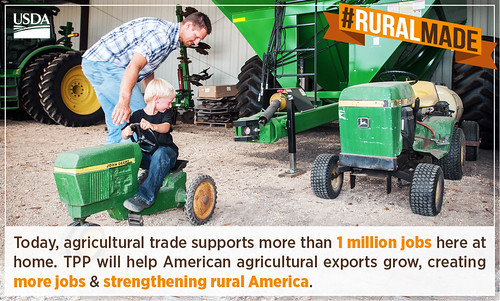The Trans-Pacific Partnership (TPP), the largest multilateral trade agreement since NAFTA, will break down barriers to trade and create significant new opportunities for U.S. agriculture. The United States and 11 other Pacific Rim countries finalized the terms of the deal in October and it must now be ratified by all the TPP member countries. When it comes to TPP passage, all of us in American agriculture have a stake in the game. Here’s why:
- The TPP is all about opportunity. The agreement will advance U.S. economic interests in the Asia-Pacific region, which accounts for nearly 40 percent of global GDP, and will boost demand for U.S. food and agricultural products among nearly 500 million consumers in 11 TPP partner countries.
- The TPP will open markets for U.S. food and farm products. The agreement strengthens trade rules and provides significant new opportunities for U.S. agricultural exports, especially to Japan, Malaysia, Vietnam, New Zealand and Brunei.
- The TPP will slash tariffs on U.S. goods. The agreement immediately eliminates tariffs on a vast number of farm and food products, with others phased out over time.
- The TPP will help U.S. agriculture remain competitive. The agreement is necessary for U.S. exports to remain competitive in the Asia-Pacific region, where many other exporting countries already enjoy preferential treatment under existing trade agreements.
- The TPP is good for rural America. Agricultural exports already provide 20 percent of U.S. farm income and support 1 million American jobs. The trade opportunities created by the TPP will boost farm income, support more local jobs, and generate new economic activity across rural America.
For more information about the TPP and its benefits to U.S. agriculture, visit www.fas.usda.gov/tpp.


